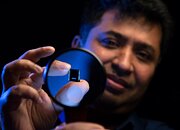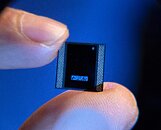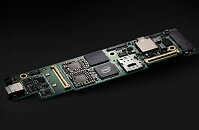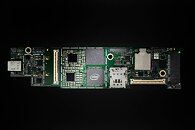Tuesday, February 11th 2020

Intel Zooms in on "Lakefield" Foveros Package
The fingernail-size Intel chip with Foveros technology is a first-of-its kind. With Foveros, processors are built in a totally new way: not with the various IPs spread out flat in two dimensions, but with them stacked in three dimensions. Think of a chip designed as a layer cake (a 1-millimeter-thick layer cake) versus a chip with a more-traditional pancake-like design. Intel's Foveros advanced packaging technology allows Intel to "mix and match" technology IP blocks with various memory and I/O elements - all in a small physical package for significantly reduced board size. The first product designed this way is "Lakefield," the Intel Core processor with Intel hybrid technology.
Industry analyst firm The Linley Group recently named Intel's Foveros 3D-stacking technology as "Best Technology" in its 2019 Analysts' Choice Awards. "Our awards program not only recognizes excellence in chip design and innovation, but also acknowledges the products that our analysts believe will have an impact on future designs," said Linley Gwennap, of The Linley Group.For its part, Lakefield represents an entirely new class of chip. It delivers an optimal balance of performance and efficiency with best-in-class connectivity in a small footprint - Lakefield's package area measures just 12-by-12-by-1 millimeters. Its hybrid CPU architecture combines power-efficient "Tremont" cores with a performance scalable 10 nm "Sunny Cove" core to intelligently deliver productivity performance when needed and power-sipping efficiency when not needed for long battery life.
These benefits offer original equipment manufacturers more flexibility for thin-and-light form factor PCs, including the emerging dual-screen and foldable screen PC categories.
Recently, three designs have been announced that are powered by Lakefield and were co-engineered with Intel. In October 2019, Microsoft previewed the Surface Neo, a dual-screen device. And later that month at its developer conference, Samsung announced the Galaxy Book S. Unveiled at CES 2020 and expected to ship midyear is the Lenovo ThinkPad X1 Fold.
Industry analyst firm The Linley Group recently named Intel's Foveros 3D-stacking technology as "Best Technology" in its 2019 Analysts' Choice Awards. "Our awards program not only recognizes excellence in chip design and innovation, but also acknowledges the products that our analysts believe will have an impact on future designs," said Linley Gwennap, of The Linley Group.For its part, Lakefield represents an entirely new class of chip. It delivers an optimal balance of performance and efficiency with best-in-class connectivity in a small footprint - Lakefield's package area measures just 12-by-12-by-1 millimeters. Its hybrid CPU architecture combines power-efficient "Tremont" cores with a performance scalable 10 nm "Sunny Cove" core to intelligently deliver productivity performance when needed and power-sipping efficiency when not needed for long battery life.
These benefits offer original equipment manufacturers more flexibility for thin-and-light form factor PCs, including the emerging dual-screen and foldable screen PC categories.
Recently, three designs have been announced that are powered by Lakefield and were co-engineered with Intel. In October 2019, Microsoft previewed the Surface Neo, a dual-screen device. And later that month at its developer conference, Samsung announced the Galaxy Book S. Unveiled at CES 2020 and expected to ship midyear is the Lenovo ThinkPad X1 Fold.





15 Comments on Intel Zooms in on "Lakefield" Foveros Package
Anyway Feveros or any other 3d stacking has real limitations, for instance I don't see a 1650 super equivalent being paired with a 10900k in package & still be able to perform at its optimal best.
It simply doesn't work the way it's portrayed & if it isn't TEC then perhaps you could link us to the said patent or cooling technology?
patents.google.com/patent/US7893529B2/en
www.freepatentsonline.com/10210912.html
patents.google.com/patent/US20130119528A1/en
Also here's a great read on how achievable 3D stacking is even without exotic thermal management.
citeseerx.ist.psu.edu/viewdoc/download?doi=10.1.1.130.6198&rep=rep1&type=pdf
Stacking high power chips makes no sense and is unlikely to happen, ever. That's not the target product segment.
And of course stacking will make chips more expensive.
Size gains are anything but trivial. Mobile packages are enormous - especially when a more powerful GPU is added to the mix.
Moreover, Foveros is not just about the SoC. It also includes RAM - effectively (at least) halving the total area of these components on a PCB.Or you just don't understand the problem? :)
So while Lakefield looks cool it's essentially a paperweight until it's widely available. Make it happen Intel!
Intel Xe Graphics to Feature MCM-like Configurations, up to 512 EU on 500 W TDP
Xe will stack computing cores with memory - not computing layers.
In fact, once their get this technology cheap, there's not reason not to use it as much as possible. So we should see stacked CPU caches as well.